Yinheng Li
Can Open-source LLMs Enhance Data Synthesis for Toxic Detection?: An Experimental Study
Dec 03, 2024Abstract:Effective toxic content detection relies heavily on high-quality and diverse data, which serves as the foundation for robust content moderation models. This study explores the potential of open-source LLMs for harmful data synthesis, utilizing prompt engineering and fine-tuning techniques to enhance data quality and diversity. In a two-stage evaluation, we first examine the capabilities of six open-source LLMs in generating harmful data across multiple datasets using prompt engineering. In the second stage, we fine-tune these models to improve data generation while addressing challenges such as hallucination, data duplication, and overfitting. Our findings reveal that Mistral excels in generating high-quality and diverse harmful data with minimal hallucination. Furthermore, fine-tuning enhances data quality, offering scalable and cost-effective solutions for augmenting datasets for specific toxic content detection tasks. These results emphasize the significance of data synthesis in building robust, standalone detection models and highlight the potential of open-source LLMs to advance smaller downstream content moderation systems. We implemented this approach in real-world industrial settings, demonstrating the feasibility and efficiency of fine-tuned open-source LLMs for harmful data synthesis.
Can Open-source LLMs Enhance Data Augmentation for Toxic Detection?: An Experimental Study
Nov 18, 2024Abstract:High-quality, diverse harmful data is essential to addressing real-time applications in content moderation. Current state-of-the-art approaches to toxic content detection using GPT series models are costly and lack explainability. This paper investigates the use of prompt engineering and fine-tuning techniques on open-source LLMs to enhance harmful data augmentation specifically for toxic content detection. We conduct a two-stage empirical study, with stage 1 evaluating six open-source LLMs across multiple datasets using only prompt engineering and stage 2 focusing on fine-tuning. Our findings indicate that Mistral can excel in generating harmful data with minimal hallucination. While fine-tuning these models improves data quality and diversity, challenges such as data duplication and overfitting persist. Our experimental results highlight scalable, cost-effective strategies for enhancing toxic content detection systems. These findings not only demonstrate the potential of open-source LLMs in creating robust content moderation tools. The application of this method in real industrial scenarios further proves the feasibility and efficiency of the fine-tuned open-source LLMs for data augmentation. We hope our study will aid in understanding the capabilities and limitations of current models in toxic content detection and drive further advancements in this field.
VideoWebArena: Evaluating Long Context Multimodal Agents with Video Understanding Web Tasks
Oct 24, 2024
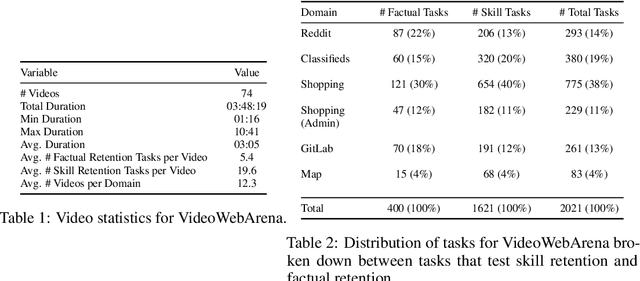
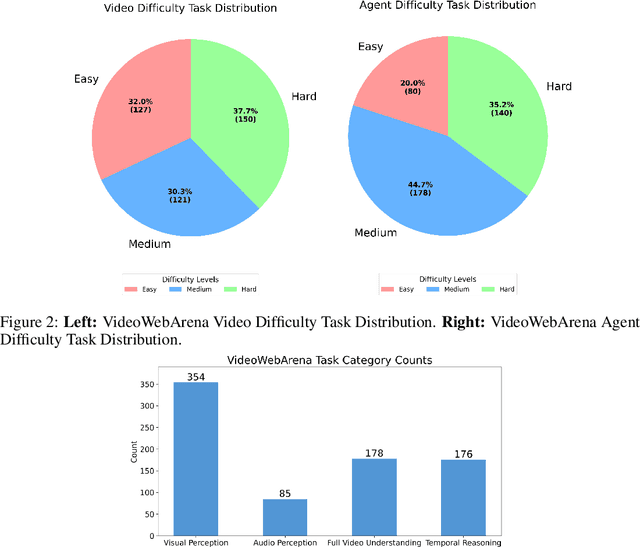
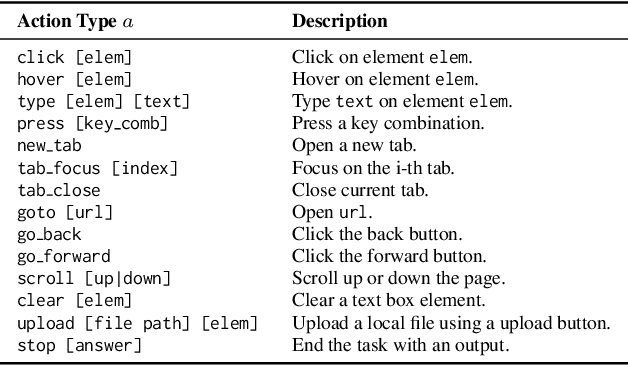
Abstract:Videos are often used to learn or extract the necessary information to complete tasks in ways different than what text and static imagery alone can provide. However, many existing agent benchmarks neglect long-context video understanding, instead focusing on text or static image inputs. To bridge this gap, we introduce VideoWebArena (VideoWA), a benchmark for evaluating the capabilities of long-context multimodal agents for video understanding. VideoWA consists of 2,021 web agent tasks based on manually crafted video tutorials, which total almost four hours of content. For our benchmark, we define a taxonomy of long-context video-based agent tasks with two main areas of focus: skill retention and factual retention. While skill retention tasks evaluate whether an agent can use a given human demonstration to complete a task efficiently, the factual retention task evaluates whether an agent can retrieve instruction-relevant information from a video to complete a task. We find that the best model achieves 13.3% success on factual retention tasks and 45.8% on factual retention QA pairs, far below human performance at 73.9% and 79.3%, respectively. On skill retention tasks, long-context models perform worse with tutorials than without, exhibiting a 5% performance decrease in WebArena tasks and a 10.3% decrease in VisualWebArena tasks. Our work highlights the need to improve the agentic abilities of long-context multimodal models and provides a testbed for future development with long-context video agents.
Windows Agent Arena: Evaluating Multi-Modal OS Agents at Scale
Sep 12, 2024
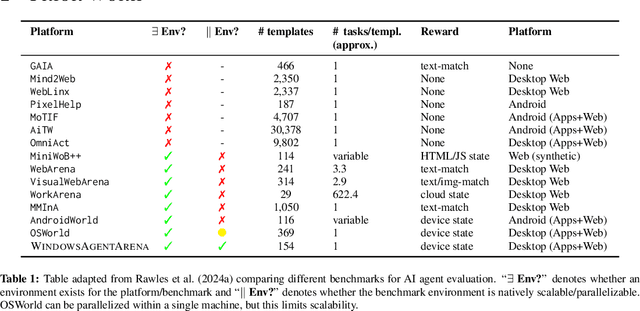
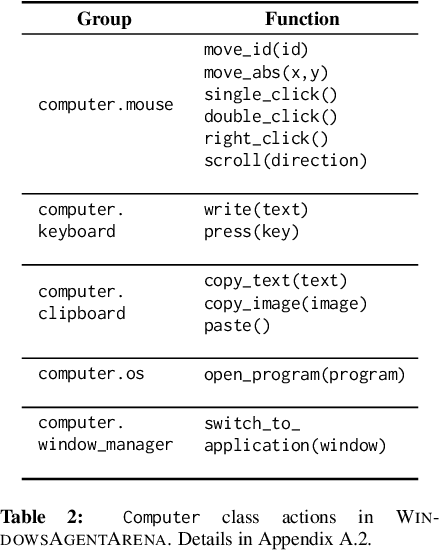
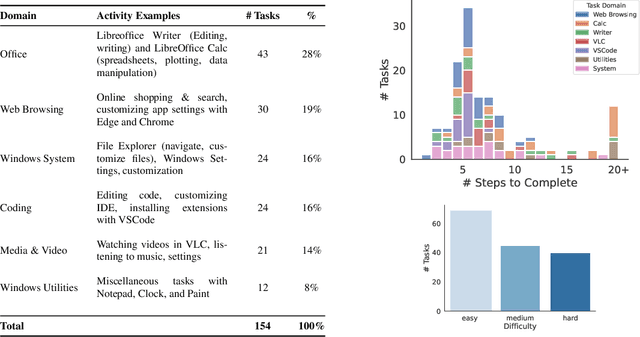
Abstract:Large language models (LLMs) show remarkable potential to act as computer agents, enhancing human productivity and software accessibility in multi-modal tasks that require planning and reasoning. However, measuring agent performance in realistic environments remains a challenge since: (i) most benchmarks are limited to specific modalities or domains (e.g. text-only, web navigation, Q&A, coding) and (ii) full benchmark evaluations are slow (on order of magnitude of days) given the multi-step sequential nature of tasks. To address these challenges, we introduce the Windows Agent Arena: a reproducible, general environment focusing exclusively on the Windows operating system (OS) where agents can operate freely within a real Windows OS and use the same wide range of applications, tools, and web browsers available to human users when solving tasks. We adapt the OSWorld framework (Xie et al., 2024) to create 150+ diverse Windows tasks across representative domains that require agent abilities in planning, screen understanding, and tool usage. Our benchmark is scalable and can be seamlessly parallelized in Azure for a full benchmark evaluation in as little as 20 minutes. To demonstrate Windows Agent Arena's capabilities, we also introduce a new multi-modal agent, Navi. Our agent achieves a success rate of 19.5% in the Windows domain, compared to 74.5% performance of an unassisted human. Navi also demonstrates strong performance on another popular web-based benchmark, Mind2Web. We offer extensive quantitative and qualitative analysis of Navi's performance, and provide insights into the opportunities for future research in agent development and data generation using Windows Agent Arena. Webpage: https://microsoft.github.io/WindowsAgentArena Code: https://github.com/microsoft/WindowsAgentArena
Data Processing Techniques for Modern Multimodal Models
Jul 27, 2024Abstract:Data processing plays an significant role in current multimodal model training. In this paper. we provide an comprehensive review of common data processing techniques used in modern multimodal model training with a focus on diffusion models and multimodal large language models (MLLMs). We summarized all techniques into four categories: data quality, data quantity, data distribution and data safety. We further present our findings in the choice of data process methods in different type of models. This study aims to provide guidance to multimodal models developers with effective data processing techniques.
The Prompt Report: A Systematic Survey of Prompting Techniques
Jun 06, 2024Abstract:Generative Artificial Intelligence (GenAI) systems are being increasingly deployed across all parts of industry and research settings. Developers and end users interact with these systems through the use of prompting or prompt engineering. While prompting is a widespread and highly researched concept, there exists conflicting terminology and a poor ontological understanding of what constitutes a prompt due to the area's nascency. This paper establishes a structured understanding of prompts, by assembling a taxonomy of prompting techniques and analyzing their use. We present a comprehensive vocabulary of 33 vocabulary terms, a taxonomy of 58 text-only prompting techniques, and 40 techniques for other modalities. We further present a meta-analysis of the entire literature on natural language prefix-prompting.
AMPCliff: quantitative definition and benchmarking of activity cliffs in antimicrobial peptides
Apr 15, 2024Abstract:Activity cliff (AC) is a phenomenon that a pair of similar molecules differ by a small structural alternation but exhibit a large difference in their biochemical activities. The AC of small molecules has been extensively investigated but limited knowledge is accumulated about the AC phenomenon in peptides with canonical amino acids. This study introduces a quantitative definition and benchmarking framework AMPCliff for the AC phenomenon in antimicrobial peptides (AMPs) composed by canonical amino acids. A comprehensive analysis of the existing AMP dataset reveals a significant prevalence of AC within AMPs. AMPCliff quantifies the activities of AMPs by the metric minimum inhibitory concentration (MIC), and defines 0.9 as the minimum threshold for the normalized BLOSUM62 similarity score between a pair of aligned peptides with at least two-fold MIC changes. This study establishes a benchmark dataset of paired AMPs in Staphylococcus aureus from the publicly available AMP dataset GRAMPA, and conducts a rigorous procedure to evaluate various AMP AC prediction models, including nine machine learning, four deep learning algorithms, four masked language models, and four generative language models. Our analysis reveals that these models are capable of detecting AMP AC events and the pre-trained protein language ESM2 model demonstrates superior performance across the evaluations. The predictive performance of AMP activity cliffs remains to be further improved, considering that ESM2 with 33 layers only achieves the Spearman correlation coefficient=0.50 for the regression task of the MIC values on the benchmark dataset. Source code and additional resources are available at https://www.healthinformaticslab.org/supp/ or https://github.com/Kewei2023/AMPCliff-generation.
A Practical Survey on Zero-shot Prompt Design for In-context Learning
Sep 22, 2023Abstract:The remarkable advancements in large language models (LLMs) have brought about significant improvements in Natural Language Processing(NLP) tasks. This paper presents a comprehensive review of in-context learning techniques, focusing on different types of prompts, including discrete, continuous, few-shot, and zero-shot, and their impact on LLM performance. We explore various approaches to prompt design, such as manual design, optimization algorithms, and evaluation methods, to optimize LLM performance across diverse tasks. Our review covers key research studies in prompt engineering, discussing their methodologies and contributions to the field. We also delve into the challenges faced in evaluating prompt performance, given the absence of a single "best" prompt and the importance of considering multiple metrics. In conclusion, the paper highlights the critical role of prompt design in harnessing the full potential of LLMs and provides insights into the combination of manual design, optimization techniques, and rigorous evaluation for more effective and efficient use of LLMs in various NLP tasks.
* Published in International Conference Recent Advances in Natural Language Processing (RANLP2023) https://ranlp.org/ranlp2023/index.php/accepted-papers/
Utilizing Large Language Models for Natural Interface to Pharmacology Databases
Jul 26, 2023Abstract:The drug development process necessitates that pharmacologists undertake various tasks, such as reviewing literature, formulating hypotheses, designing experiments, and interpreting results. Each stage requires accessing and querying vast amounts of information. In this abstract, we introduce a Large Language Model (LLM)-based Natural Language Interface designed to interact with structured information stored in databases. Our experiments demonstrate the feasibility and effectiveness of the proposed framework. This framework can generalize to query a wide range of pharmaceutical data and knowledge bases.
Self-Supervised Image Representation Learning: Transcending Masking with Paired Image Overlay
Jan 23, 2023Abstract:Self-supervised learning has become a popular approach in recent years for its ability to learn meaningful representations without the need for data annotation. This paper proposes a novel image augmentation technique, overlaying images, which has not been widely applied in self-supervised learning. This method is designed to provide better guidance for the model to understand underlying information, resulting in more useful representations. The proposed method is evaluated using contrastive learning, a widely used self-supervised learning method that has shown solid performance in downstream tasks. The results demonstrate the effectiveness of the proposed augmentation technique in improving the performance of self-supervised models.
 Add to Chrome
Add to Chrome Add to Firefox
Add to Firefox Add to Edge
Add to Edge